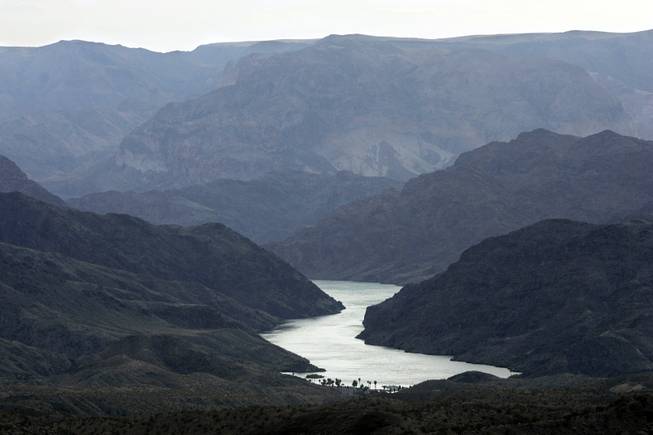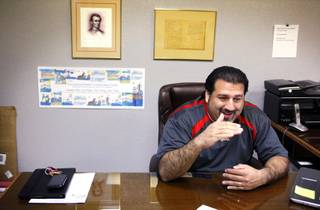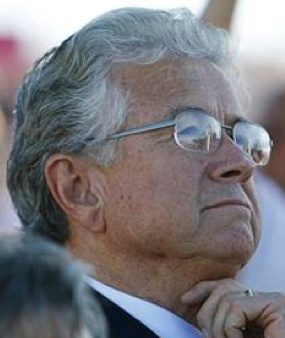
Nevada has gotten its water from the Colorado River, above, since an agreement among seven states was ratified in 1928. As growth continued to swell the population, Las Vegas began eyeing the water under the Great Basin Desert.
Thursday, Feb. 2, 2012 | 2 a.m.
Sun coverage
An organization led by Latinos in five states, including Nevada, wants a new, long-term study of the Colorado River basin to look beyond sustaining a healthy waterway and take into account the basin’s Latino heritage.
“It’s not just ‘a’ river; it’s ‘our’ river. It has a historical and cultural importance to many groups of people,” said Andres Ramirez, Nevada director for Nuestro Rio (Our River), a group that started in 2011 in Nevada, Colorado and New Mexico and is currently increasing its efforts in Arizona and California. “The Colorado River is the lifeline of the Southwest, and not only does the river need to be preserved for generations to come, but also the cultural heritage of the river basin.”
The U.S. Bureau of Reclamation is set to release a Colorado River basin study that will be the basis for water policy for the next 50 years. The study, which will assess water supply and demand imbalances while offering possible solutions, began in January 2010 and is due in July.
Nuestro Rio representatives, concerned about the lack of details offered about how the study would be conducted, met with staff from the Bureau of Reclamation and Department of the Interior in 2011 to offer their input.
The Colorado River Compact, the seven-state agreement that is considered the cornerstone of the laws and agreements governing the waterway, was completed in 1922. Since then, water usage in the basin has escalated from approximately 5 million acre-feet per year to more than 15 million acre-feet per year.
Starting at its headwaters in Rocky Mountain National Park, the Colorado River weaves its way more than 1,450 miles through five states and Mexico before emptying into the Gulf of California. Along the way, its waters irrigate 15 percent of crops grown in the United States and nourish 13 percent of the nation’s livestock.
Yet, the river no longer culminates in lush, biologically diverse estuaries along the Sea of Cortez. Instead, it stumbles to the finish line with nothing more than a trickle of water where fisheries once thrived 80 years ago. Ramirez said the sandy, desolate flats off the Sea of Cortez, where fisherman once worked a delta teeming with life, are the perfect example of how whole communities, and their heritage, can be lost when the river changes.
Locally, the effects of increasing demands on the river can be seen in the perpetually plunging levels of Lake Mead, which hit a 75-year low in 2010 before rebounding slightly in 2011, according to Bureau of Reclamation data.
In the past 50 years, the population living in the river basin has more than doubled to 30 million. Predicting growth, though, is an inexact science.
“For example, population growth has been hard to predict in the Las Vegas area,” said Ramirez, 33. “As the population increases, water conservation methods and technology improves. In this area, we have some 40 million tourists every year who need to be accounted for. A lot of factors are involved.”
Nuestro Rio’s efforts go beyond talking to federal bureaucrats about the study.
The organization conducts town-hall forums quarterly in each of the states it serves, and the next one in Las Vegas is tentatively scheduled for the end of February.
In August, Nuestro Rio had one of its first big events at the East Las Vegas Community Center, and the turnout was encouraging to organizers.
“I was expecting a handful of people, and to my surprise there was a room of about 100 to 150 community leaders,” said state Sen. Ruben Kihuen, who spoke at the event. “It was indicative of the importance of the issue. It’s not the sexiest issue, like immigration or jobs or education, but it is an issue that the entire community should be aware of. Without the Colorado River, Las Vegas would not exist today.”
In October, Nuestro Rio took more than 30 Las Vegas elementary school students on a field trip to a section of the river.
In the spring, Nuestro Rio plans to release a “corrido” (ballad) about the Colorado River. The song will then be performed by groups in all five states where Nuestro Rio operates and made into a music video.
Mi Familia Vota, a national organization that works to increase civic engagement among Latinos, also supports the cause and is running radio spots supporting the Obama administration’s decision to place a moratorium on uranium mining close to the Grand Canyon.
“We want to help create awareness about the environmental challenges we face with the Colorado River,” said Leo Murrieta, 25, Mi Familia Vota Nevada director. Murrieta has been going to Lake Mead all his life and laments the changes to his favorite swimming spots. “It’s part of our heritage and our community, and it’s been that way for generations.”
Las Vegas City Councilman Bob Coffin, who is also on the Colorado River Commission of Nevada, has supported Nuestro Rio in its efforts.
“We know now that previous estimates of water flow were way overblown,” he said. “Now, we know all that the earth sciences have to tell us about the river, and we need to put together a better sociological view. There really hasn’t been enough done on the sociology, anthropology and history of the river. ... Now it’s happening, and I think that’s a good thing for my children and my children’s children.”
Ramirez will be keeping an eye out for the report in July, which will be followed by a public review period and then implementation.
“In the end, each state will have control over how they implement water usage plans in their area, and, when you start shifting water allocations around, the survival of some small communities could be in jeopardy,” he said. “Think of the Colorado River as a super highway. Whether or not a town falls in the right spot in relation to the highway directly impacts who survives and who doesn’t.”
For information on Nuestro Rio and its educational events and forums, visit nuestrorio.com.



Join the Discussion:
Check this out for a full explanation of our conversion to the LiveFyre commenting system and instructions on how to sign up for an account.
Full comments policy